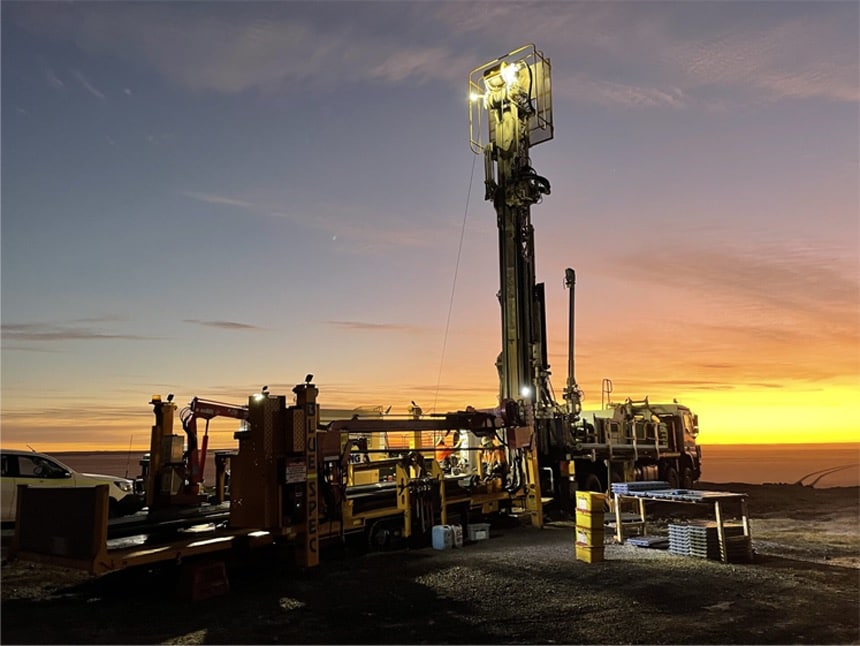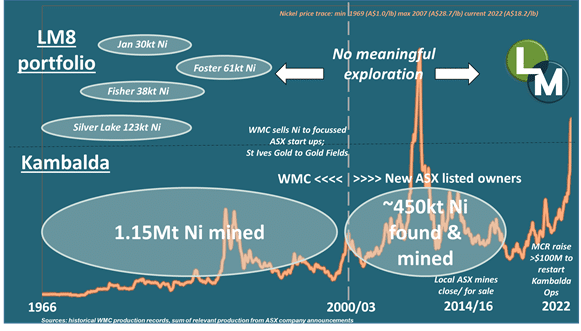

WMC ownership
History of Lunnon Metals’ portfolio
Nickel was first discovered at Kambalda by WMC Resources Ltd when diamond driller Jack Lunnon, under the direction of the famous Australian geologist, the late Dr Roy Woodall AO, intersected nickel sulphide mineralisation in drill hole KD 1 (2.7 m @ 8.3% Ni). WMC went on to explore aggressively in the broader Kambalda area leading to the discovery and definition of up to 24 deposits hosted proximal to the features known as the Kambalda Dome, the Widgiemooltha Dome and the Golden Ridge Greenstone Belt.
The nickel in that first diamond hole KD 1 was soon developed as the Lunnon Shoot (named after the driller) at WMC’s first nickel mine in the town, named Silver Lake Shaft – after the nearby shimmering white salt lake of Lake Lefroy. Silver Lake went on to mine 4.5 million tonnes of nickel ore grading 2.7% Ni for 123,318 tonnes of nickel metal – and a new globally significant nickel district was borne that to date has delivered some 1.6 million tonnes of nickel metal.
Late 90’s-Early 2000’s
WMC exits its Kambalda nickel / gold mines
In the late 1990s WMC commenced a process that ultimately would see all of its active nickel mines in the Kambalda district at that time being sold to a range of junior ASX listed companies, the main ones being Mincor Resources NL, Independence Group and Sally Malay Mining, now Panoramic Resources. These companies aggressively explored their new assets with great success and by the time the nickel price peaked in 2007/08, they were delivering nickel ore to the WMC (now Nickel West) Kambalda Concentrator under ore tolling and concentrate purchase agreements (OTCPAs) that they entered into with WMC when they bought the mines.
As WMC was selling its nickel mines at Kambalda, it also sold its gold business at Agnew and St Ives, to Gold Fields Ltd from South Africa. This was the South African company’s first move outside the African continent and the previous WMC staff at Agnew and St Ives transferred across to Gold Fields. The sale of St Ives at Kambalda to Gold Fields included four nickel mines that were already closed, the first ever nickel mine, Silver Lake, plus Fisher, Foster and Jan nickel mines, which together had produced over 253,000t of nickel metal between 1967 and 1996.
Gold Fields aggressively, and very successfully, explored for gold at Kambalda/St Ives, discovering enough new gold resources to justify the construction of a brand new 5mtpa gold plant on the south side of Lake Lefroy. Meanwhile, the four nickel mines and the nickel belts they sat on, lay dormant inside the gold major and missed the nickel price boom of the early to mid 2000s whilst Mincor Resources NL, Independence Group and Panoramic Resources generated significant free cash flow from their nickel production activities.
2014 to 2021
The high nickel prices did not last, and as the 2010s progressed, the local nickel mines slowly closed. In 2016, the last one, Long Shaft, was shut by Independence Group. However, during this period, Lunnon Metals, then known as private ACH Nickel, had joint ventured the Foster and Jan mines along with the associated Cooee Anticline nickel belt with Gold Fields. This partnership led to a re-assessment and review of the historical WMC data.
This collaboration ultimately resulted in a JORC 2012 compliant Mineral Resource of 39,000 tonnes of nickel metal. Lunnon Metals then purchased the 49% of the JV that it did not own from Gold Fields. This acquisition paved the way for Lunnon Metals to list on the ASX in June 2021, marking a significant milestone in the company’s history.

Present day
Lunnon Metals’ Strategic Discoveries and Acquisitions
Fast forward to May 2022 and Lunnon Metals has made a new discovery, Baker, in area that WMC had drilled on a broad spacing but walked away from, demonstrating the potential of the famous Kambalda nickel district to keep delivering surprises. The Company has also had great success drilling the Warren channel at the Foster mine, again in and amongst large gaps between WMC’s previous surface and underground drilling, yielding impressive widths and grades of nickel mineralisation. Whilst continued analysis and re-assaying of historical core has defined a new resource at the main Foster nickel mine, with 9,500t of nickel metal growing the Company’s Mineral resource to 48,500t in total.
In April 2022 the Company also agreed terms to acquire nickel rights to the last two historical nickel mines (and surrounding prospective belts) that have not sat in the hands of a nickel focused company since they were closed by WMC in the 1980s, Fisher and Silver Lake, finally bringing “the band back together again” after more than 20 years. The deal settled in late September/early October 2022 (see ASX announcement dated 12 April 2022 for further details of this transaction).
The value proposition is simple; Lunnon Metals aims to replicate the success of the ASX companies that acquired nickel mines from WMC in the late 1990s, early 2000s ahead of the last nickel boom, and in doing so become a key player in the nickel sector as this important forward facing metal plays a key part in the energy transition and drive to net zero targets happening around the world.

Sign Up for ASX Alerts and News to receive the latest updates, insights, and developments directly to your inbox.